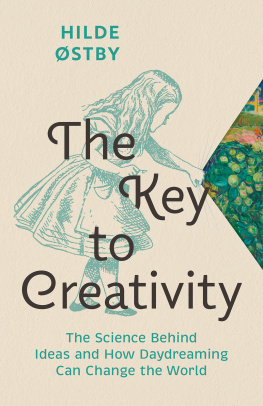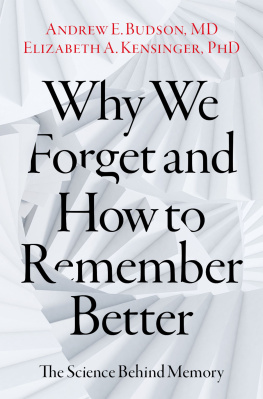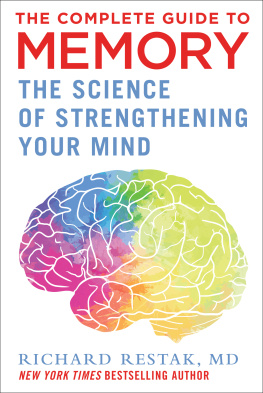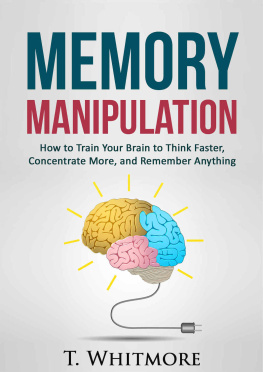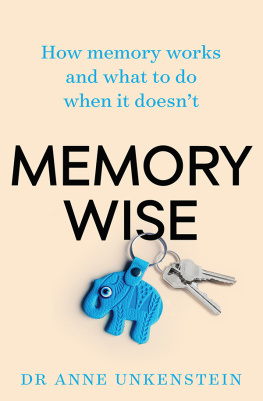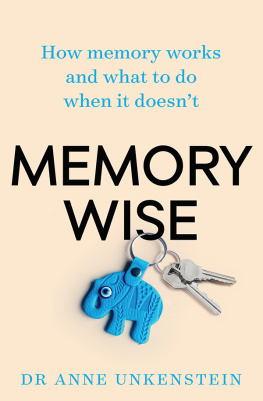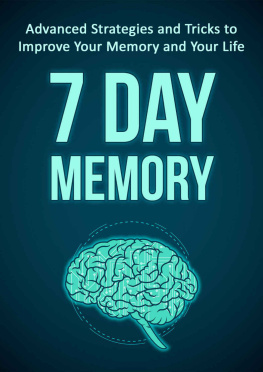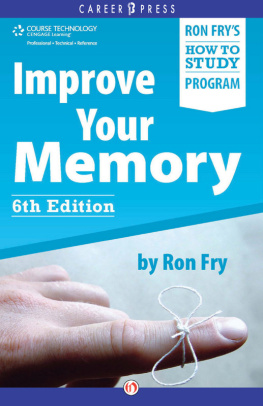
Copyright 2018 by Hilde stby and Ylva stby
Originally published in Norway in 2016 as dykke etter sjhester: En bok om
hukommelse (Diving for Seahorses: A Book About Memory)
English translation copyright 2018 by Marianne Lindvall
First published in English by Greystone Books in 2018
Foreword copyright 2018 by Sam Kean
18 19 20 21 22 5 4 3 2 1
All rights reserved. No part of this book may be reproduced, stored in a retrieval system, or transmitted, in any form or by any means, without the prior written consent of the publisher or a license from The Canadian Copyright Licensing Agency (Access Copyright). For a copyright license, visit www.accesscopyright.ca or call toll free to 1-800-893-5777.
Greystone Books Ltd.
greystonebooks.com
Cataloguing data available from Library and Archives Canada
ISBN 978-1-77164-347-4 (cloth)
ISBN 978-1-77164-345-0 (epub)
Editing by Jennifer Croll
Copy editing by Dawn Loewen
Jacket and text design by Nayeli Jimenez
Jacket illustration by H. L. Todd, U.S. National Museum
Excerpts from MAGNIFICENT DESOLATION: THE LONG JOURNEY HOME FROM THE MOON by Buzz Aldrin, copyright 2009, 2010 by StarBuzz LLC, used by permission of Harmony Books, an imprint of the Crown Publishing Group, a division of Penguin Random House LLC, and by permission of Bloomsbury Publishing Plc. All rights reserved.
Excerpts from UNQUIET by Linn Ullmann, translated by Thilo Reinhard and Linn Ullmann, copyright 2015 by Forlaget Oktober AS, Oslo, translation copyright 2019 by Linn Ullmann, used by permission of W. W. Norton & Company, Inc.
Excerpt from the FALSE MEMORY ARCHIVE used by permission of A.R. Hopwood. All rights reserved.
Every attempt has been made to trace ownership of copyrighted material. Information that will allow the publisher to rectify any credit or reference is welcome.
Greystone Books gratefully acknowledges the Musqueam, Squamish, and Tsleil-Waututh peoples on whose land our office is located.
Greystone Books thanks the Canada Council for the Arts, the British Columbia Arts Council, the Province of British Columbia through the Book Publishing Tax Credit, and the Government of Canada for supporting our publishing activities.

FOREWORD
Sam Kean
I N ONE OF Plutarchs Lives, he mentions an old philosophical conundrum now called the Ship of Theseus Paradox. After slaying the minotaur in the labyrinth, the Greek hero Theseus sails home, and the people of Athens are so overjoyed that they preserve his ship as a memorial. Being a material object, however, the ship shows some wear and tear as the years pass, and every so often the caretakers have to replace a piece of ita board here, a plank there. Eventually, after several centuries, theyve replaced every last original piece of wood. So is it still the same ship now that it was at the beginning?
You can ask a similar question about our own bodies. Were three-fourths water, molecules of which cycle into and out of us in a constant flow, never sticking around long. And because our DNA and other biomolecules break down, we swap in new parts all the time to repair them. Skin cells get recycled every few weeks, blood cells every few months, liver cells every two years. Even bone experiences constant turnover. Over the course of a decade or so, every last atom in your body gets replaced. So are you still you at the end?
Most of us feel, intuitively, that we do remain the same person from decade to decade. But how can that be if our bodies arent the same? Why do we feel this continuity so strongly? One big reason is because of our memories. The bio-bits come and go, but the pattern of information coursing through our brains remains largely consistent. In a fundamental way, then, we are our memories.
Yet, few of us really understand how memory works. We rely on misleading analogies or folk theories, or we simply remain oblivious and take it all for granted: memories bubble up so easily inside us, so effortlessly, that we rarely pause to consider just what a miracle they are.
Well, no more. After reading Adventures in Memory, youll fully appreciate what a complex, beautiful, and intricate thing memory is. Indeed, in the hands of Hilde and Ylva stby, memory is more than a simple repository of our selves. Its a creative forcesomething dynamic that actively shapes our thinking. It has all the rich, layered complexity of human beings themselves.
What makes the book unique is the double-barreled perspective the stby sisters bring. Unlike, say, electrons or black holes, memory is both an objective and a subjective phenomenon. We need to understand the neurotransmitters and electrical firing patterns involved, but memory is a lived thing too. We need both sidesin other words, the literary and the scientificto make sense of memory. Its therefore reassuring to know that Hilde stby is a novelist and her sister Ylva a neuroscientist. Imagine if another sibling pairWilliam James the famous psychologist and Henry James the brilliant novelisthad combined forces, and you can see what a valuable perspective this combination provides.
We usually think about science as ultra-rational, but its an intensely human activity as well. And its especially important to see that human side when studying memory, since it does influence our sense of self so profoundly. In exploring how memory works, then, Adventures in Memory is really a dive into your innermost selfthe most intimate aspects of your being. And when you surface from this dive, youll never see the world, or your own self, in quite the same way again.
SAM KEAN, author of Caesars Last Breath and The Tale of the Dueling Neurosurgeons
THE SEA MONSTER
Or: The discovery of the hippocampus
Your memory is a monster; you forgetit doesnt. It simply files things away. It keeps things for you, or hides things from youand summons them to your recall with a will of its own. You think you have a memory; but it has you!
JOHN IRVING, A Prayer for Owen Meany
A T THE BOTTOM of the ocean, tail curled around seagrass, the male seahorse sways back and forth in the current. He may be tiny and mysterious, but no ocean creature compares to him. The only male in the animal kingdom to become pregnant, he stands on guard, carrying his eggs in his pouch until they hatch and the fry swim away into the open sea.
But lets back up: this isnt a book about seahorses. To find our real subject, we must rise out of the depths and journey back 450 years.
The year is 1564. Were in Bologna, Italy, a city full of elegant brick buildings and shady, vine-covered walkways. Here, at the worlds first proper university, Dr. Julius Caesar Arantius bends over a beautiful object. Well, beautiful might be an exaggeration, if youre not already deeply, passionately involved in its study. Its a human brain. Rather gray and unassuming, and on loan from a nearby mortuary. Students surround the doctor, clustered on benches throughout the theater, following his work intently, as though he and the organ in front of him are the two leads in a drama. Arantius leans over the brain and slices through its outer layers, studying each fraction of an inch with extreme interest, hoping to understand what it does. His disregard for religious authority is clear in the gusto with which he approaches his dissection because, until shortly before that time, the scientific study of human corpses had been strictly forbidden.


